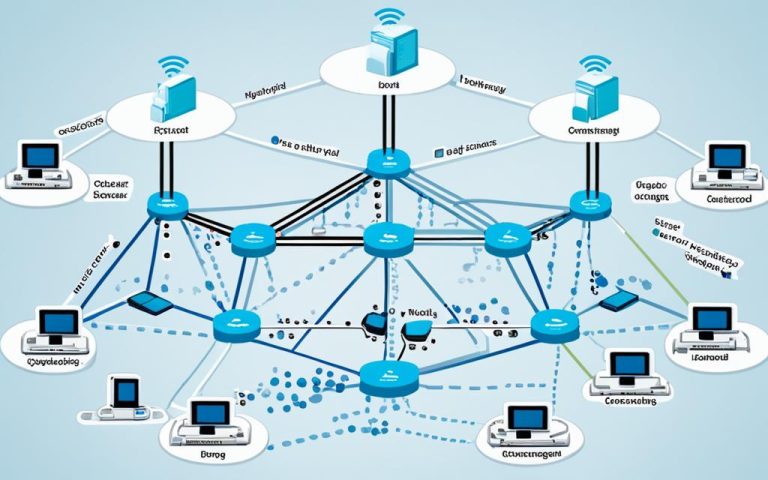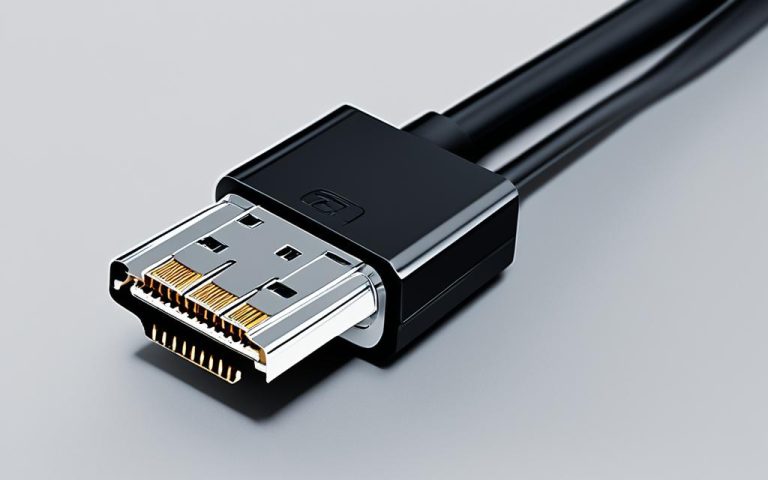For small companies, having a well-designed network is key for smooth operations and growth. Planning and implementing a network redesign are vital for efficiency, productivity, and keeping up with digital changes.
A small company’s network should match its unique needs and goals. By looking at the current network setup and finding ways to improve, businesses can lay a strong base for growth.
Technology and the internet are more important than ever for small businesses1. shows that about 30% of small businesses lack a website, down from 50% in 2018. This shows how crucial it is to boost online presence to reach more customers and grow.
A bad website design can hurt a small business a lot. Research says 38% of people won’t stick around if a website looks bad or is hard to use. So, small businesses should put money into good website design. This means focusing on consistent branding, clear messaging, and smart SEO to draw in and keep customers.
Key Takeaways:
- Network redesign is key for small companies to support growth and smooth operations.
- About 30% of small businesses lack a website, showing the need for better online presence.
- 38% of people leave a website that’s not well designed, highlighting the need for good design.
- Good branding, clear messaging, and smart SEO are vital for small business websites.
Importance of Small Business Network Design
A well-designed network is key for small businesses to stay safe from threats like software bugs and viruses. It helps protect against network weaknesses.
Having the latest software and top-notch routing and hardware is vital for a secure network.
Small businesses can pick between wireless or wired networks, depending on what they need2.
Wireless networks let devices connect without cables, using Wi-Fi signals from a router2.
Wired networks use Ethernet cables for a steady and fast connection. This is great for businesses with many devices2.
Hybrid networks mix wired and wireless, letting mobile devices go wireless while keeping desktops and servers stable2.
Good network design looks at the router’s spot, how many computers are there, and how info moves around the company2.
Key devices for small businesses include modems, routers, switches, firewalls, access points, repeaters, and patch panels2.
Routers help direct data, and switches help devices talk to each other in a network2.
Managed and unmanaged switches give different levels of control over network traffic. Managed ones are better for big networks2.
Choosing the right gear, like routers that handle lots of devices and reduce Wi-Fi issues, is key for a growing business network2.
Things like routers, switches, firewalls, and servers are key for a strong and safe network for small businesses2.
Every device, like the modem, router, and firewall, is important for a reliable internet connection and security against threats2.
Components of a Small Business Network
Setting up a network for a small company includes many parts. You’ll need a secure Internet connection from an Internet Service Provider (ISP). Also, a router with fast Internet, a modem, and a firewall for security. You’ll also need switches for connecting devices, and options like phone lines or fiber optic for linking. Plus, Ethernet hubs and software for managing and securing your network.
The Role of the Internet Service Provider (ISP)
An Internet Service Provider is key for small businesses. They make sure the business has a steady Internet connection. This lets employees use the Internet for work, email, and other tasks smoothly. It’s important to pick an ISP with fast and reliable Internet to boost productivity.
Router and Modem
A router is the heart of a small business network. It lets many devices connect to the Internet at once. It connects the local network to the ISP, sending data where it needs to go. A modem is also needed to turn the ISP’s signal into something devices can understand.
Firewall for Enhanced Security
Keeping a small business network safe is crucial. A firewall is a key tool for security. It stops threats and only lets in approved traffic. With a strong firewall, small businesses can protect against cyber threats and keep their data safe.
Switches for Internal Network Connectivity
Switches help devices talk to each other in a network. They connect computers, servers, and printers for smooth data sharing. Small businesses can choose between managed or unmanaged switches based on their needs.
Wired and Wireless Linking Options
Small businesses can choose between wired and wireless connections. Wired connections are stable and great for devices needing constant, high-speed Internet. Wireless connections are handy and let employees work without cables. Wi-Fi makes it easy for devices like smartphones and laptops to connect.
Ethernet Hubs for Network Expansion
Ethernet hubs add more ports to a network, letting more devices join. They’re perfect for growing businesses. These hubs keep data moving fast, even with lots of devices connected.
Management and Security Software
Management and security software are a must for small businesses. They help monitor and protect the network. With these tools, businesses can keep their network running well, fix problems, and stay safe from cyber threats.
Creating a strong small business network means picking and combining the right parts. Think about how well it works, how secure it is, and how easy it is to manage. This way, small businesses can have a network that supports their work and grows with them.
References:
- 3 Statistical data extracted from Link 1
Network Configuration Types for Small Businesses
When setting up a network for a small business, it’s key to think about what the company really needs. Small businesses have many network options to choose from. This lets them create networks that fit their unique needs and goals.
Local Area Network (LAN): A LAN is a great choice for small businesses. It connects devices close together, like in an office or a certain area. LANs use Ethernet to let employees share files and data easily2.
Wide Area Network (WAN): WANs connect devices that are far apart. They’re perfect for linking different offices or branches of a business. WANs help businesses with many locations stay connected and share data smoothly2.
Metropolitan Area Network (MAN): MANs are used in cities and towns. They cover big areas and connect different places, like schools and businesses. MANs make it easy to share resources and communicate in a certain area2.
Personal Area Network (PAN): PANs are for small setups, like home offices or personal workstations. They link devices like computers and phones, helping people manage their work efficiently2.
Campus Area Network (CAN): CANs are common in schools. They connect different LANs on a campus. This lets students and staff share resources and talk easily across departments2.
Knowing about these network types helps small businesses make smart choices. It’s important to look at what the company needs and pick the right network setup. This should match the company’s goals, budget, and plans for the future.
| Network Configuration Type | Definition |
|---|---|
| Local Area Network (LAN) | A network connecting devices within a close proximity, such as an office building. |
| Wide Area Network (WAN) | A network connecting devices that are farther apart, often used to connect remote offices or branches. |
| Metropolitan Area Network (MAN) | A network covering a larger area within a city or town, connecting organizations and businesses. |
| Personal Area Network (PAN) | A network designed for individual workstations or home offices, connecting multiple devices. |
| Campus Area Network (CAN) | A network linking LANs within a specific educational campus or institution. |
Importance of Network Security in Small Businesses
Network security is key for small businesses to keep their data safe and operations smooth. It’s crucial to use strong security steps like data protection and network encryption. This helps fight off cyber threats today.
Using strong encryption and complex passwords makes it hard for hackers to get into your data. Small businesses can keep their network safe by using wireless encryption like WPA2 or WPA3. This stops unauthorized people from listening in on your network.
It’s also important to control who can see what on your network. By setting rules for access, you can stop unauthorized people from getting into your data. This way, only those who should see certain information can do so.
Many small businesses have remote workers or employees accessing the network from different places. A Virtual Private Network (VPN) can help keep their data safe. VPNs make a secure tunnel for data, keeping it safe from prying eyes, even when using public networks.
For businesses with guest Wi-Fi, having a separate network for guests is a must. This keeps guests from seeing your business data. It also stops them from getting into your systems or customer info. This keeps your business safe from security risks.
Keeping your network devices up to date is key for security. Small businesses should update their routers, switches, and firewalls regularly. This helps stop cybercriminals from taking advantage of old vulnerabilities.
But security isn’t just about digital stuff. Keeping devices like routers and switches safe from physical harm is also important. Locking them up in secure places helps prevent tampering or theft.
Here are some stats that show why network security is so important for small businesses:
- Sixty-six percent of the 30 million SMBs in the U.S. faced a security issue from 2018 to4.
- 50% of cyber attacks happen to small- and medium-sized4.
- Network devices are often targeted by hackers because they’re key for sharing data5.
- Many network device owners don’t change default settings or apply security updates5.
These numbers highlight the need for strong cybersecurity steps to protect small businesses. By being proactive, they can keep their data safe, build trust with customers, and grow their business.
Example Best Practices for Network Security in Small Businesses
Use network segmentation to stop malware from spreading and keep bad activities in check5.
Use VLANs, VRF tech, and VPNs to keep sensitive data safe5.
Limit who can talk to whom on your network with firewalls and network rules5.
Make network devices more secure by turning off unneeded remote access and using strong passwords5.
Control who can touch your network devices and back up settings often5.
Keep access to devices secure with multi-factor authentication and manage who has special access5.
Importance of Software Security Tools in Network Design
Software security tools are key in network design. They protect against weaknesses and track data reliably for small businesses. These tools shield networks from threats like web security breaches and bandwidth issues.
Web security is a big part of network design. Tools for web protection help small businesses keep their networks safe from cyber risks. They block malware and stop unauthorized access, keeping data safe and secure.
Managed antivirus software is also crucial. It fights malware in real-time, keeping small businesses safe. With these tools, businesses can spot and fix security risks fast, keeping their networks safe.
Mail protection solutions are also vital for small businesses. They filter out bad emails, reducing phishing attacks. This keeps sensitive info safe and prevents data breaches.
Patch management tools keep networks secure and up-to-date. They make sure systems and devices have the latest security updates. This reduces the risk of security breaches, keeping networks safe.
Backup tools are key for network design too. They back up important data securely. In case of a security issue or data loss, these tools help businesses recover fast. This keeps data available and reduces downtime.
Remote management software is a must for network admins. It lets them manage the network from anywhere, keeping an eye on everything. This makes managing hardware and software easier, ensuring the network runs smoothly.
Software security tools are vital in network design. They fix weaknesses, track data reliably, and boost web and bandwidth security. These tools help small businesses protect their data and tech from cyber threats.
Statistical data referenced from6 Cisco’s PPDIOO model has stages like Prepare, Plan, Design, Implement, Operate, and Optimize. Other models include Cisco’s PBM and NDLC. Traditional networks have three layers: Core, Distribution, and Access. Top-down and bottom-up design start from different levels. The design process looks at business and tech needs, like bandwidth and security. Choosing the right hardware and software is key. Planning for implementation includes deployment, testing, and project management for success. Aligning business needs with stakeholder expectations is crucial for a successful network design.
Network Design Best Practices
For small businesses, it’s key to follow network design best practices. This ensures your network works well, grows, and stays secure. By planning carefully, you can build a network that fits your needs now and later.
Keeping things simple in your network design is a top rule. A simple network is easier to manage and less prone to problems. It means avoiding extra parts and having a clear subnet plan for better understanding and management7.
Security is a big deal in network design too. Small businesses should use firewalls, intrusion detection, and encryption to keep data safe from cyber threats8. A secure network keeps your important info safe and available.
Documentation is super important for network design and upkeep. It helps with fixing problems, recovering from issues, and making changes later. Good documentation makes teamwork easier and helps new IT staff get up to speed faster9.
Think about scalability when designing your network. This is key for businesses that will grow. A scalable network can handle more devices and services later on. Planning for growth means you won’t have to redo your network a lot, making it easier to grow79.
Watching your network closely is key to spotting and fixing problems fast. Regular checks and analysis of network data help find weak spots and slow parts. Tools for monitoring networks give insights to make it run better and avoid downtime7.
Lastly, a flexible network is a must. Needs change over time, and your network should too. A flexible design lets you make changes and add new tech as needed, keeping up with your business’s growth89.
Steps to Designing a Network for Small Businesses
Creating a network for a small business needs careful planning. It’s important to think about different factors. By taking a step-by-step approach, small businesses can make a network that fits their needs.
1. Identify Network Design Requirements
The first thing to do is figure out what the business needs from its network. Think about the business’s size, how much network coverage is needed, and any special network requirements.
2. Choose Necessary Devices
After figuring out what the network needs, pick the right devices. This includes things like routers, switches, firewalls, and servers.
3. Determine the Network Topology
The network topology is how the network is set up. Small businesses can pick from different topologies like ring, star, bus, mesh, or tree. Choosing the right one is key for good communication and data transfer.
4. Map out Network Connections
Mapping out the network connections is a key step. It means deciding how devices will connect and setting up the right network protocols and configurations.
5. Create an Implementation Plan
After deciding on the network design, make an implementation plan. This plan will show how to put the network in place, making sure it goes smoothly from the old setup to the new one.
Following these steps and using the right devices and topology can lead to a great network for small businesses. This network supports smooth communication, fast data transfer, and boosts productivity.
“Designing a network for a small business requires careful planning and consideration of various factors. By following a step-by-step approach and incorporating the necessary devices and network topology, small businesses can create a well-designed network that fulfills their specific requirements.”
Reference:2
Importance of Network Design in Small Business Growth
A well-thought-out network is key for small business growth. It helps them grow and change easily. By focusing on flexibility and scalability from the start, small businesses can handle more users and devices as they grow.
This forward-thinking approach saves time and money when the business gets bigger. It makes sure the network can grow with the company.
Companies that use good network design tools see a 40% drop in network problems. This leads to better reliability and happier customers10. In fields like telecom and IT, using smart network planning can boost efficiency by up to 50%10.
Small businesses see a 25% boost in efficiency with a well-planned network2. Adding special firewalls makes data safer for 70% of these companies2.
Most small businesses, 60%, like hybrid networks for their flexibility and stability2. Using dual-band routers cuts network interference by 30%, making connections better2.
Thinking about scalability in network design lets small businesses invest in better switches. These improve network speed, device connections, and power use2.
Designing networks is easy for small setups but hard for big ones11. Good project management and talking to all stakeholders is key to success11.
Choosing a top-down or bottom-up approach makes sure everything is covered, like bandwidth and security11.
Using a lifecycle model like Cisco’s helps businesses design, implement, and improve their networks. This meets their changing needs11.
Conclusion
Redesigning a network is key for small businesses to stay efficient, productive, and secure. Data shows that 80% of small companies face unauthorized threats12. Adding security steps like a 30-second wait after failed logins12 boosts safety and guards against data loss.
Also, 81% of small businesses find network security accounting vital for tracking user actions12. Taking steps against reconnaissance attacks, which are 65% of threats12, helps protect networks. Dealing with malware like Trojan horses, which hit 43% of small companies12, is also crucial.
Statistical data13 shows security is key in designing networks, especially when combining IT from over 20 departments13. Old networks struggle to keep up with today’s tech needs13. So, predicting future needs and designing networks that grow with the business13 is vital.
A study on network designs for Plastic Fantastic and Cashflow14 shows the need for custom solutions14. Looking at their proposals, with shopping lists and protocols14, shows how important network consultants are14. These experts are key in creating and setting up networks that fit a company’s unique needs14.
FAQ
Why is network redesign important for small companies?
Network redesign is key for keeping networks safe and ensuring info flows well in a company. It guards against network weaknesses and threats.
What are the components of a small business network?
A small business network includes an Internet Service Provider, router, modem, firewall, switches, and more. It also has wired and wireless links, Ethernet hubs, management software, and security tools.
What are the different network configuration types for small businesses?
Small businesses can pick from LAN, WAN, MAN, PAN, and CAN networks. Each type meets different needs.
Why is network security important for small businesses?
Network security is crucial for keeping data safe and operations smooth. It stops unauthorized access, encrypts data, and uses security protocols to fight threats.
What software security tools are important in network design?
Important tools include web protection, antivirus, mail protection, patch management, backup tools, and remote management software. They boost security and reliability.
What are the best practices for network design?
Best practices include simple and secure designs, documenting the network, ensuring it can grow, monitoring it, and allowing for future changes.
What are the steps to designing a network for small businesses?
Steps include identifying what the network needs, picking the right devices, choosing a network type, mapping connections, and making an implementation plan.
How does network design contribute to small business growth?
Good network design lets small businesses grow and change easily. It supports expansion and new network needs, helping businesses grow smoothly.
How does network redesign benefit small businesses?
Redesigning the network boosts security, increases productivity, helps share info, and protects data. This leads to success for small businesses.
Source Links
- https://www.cardinaltek.com/redesigning-your-website-and-your-brand-can-revitalize-your-business/ – Redesigning Your Website Can Revitalize Your Business
- https://acisitsolutions.com/designing-a-small-business-network/ – ACIS IT Solutions | Managed Service Provider Springfield, MO
- https://gist.github.com/currentghost/6d58fa03062cd05d76a53cfe735758f2 – LAN security and Firewalls
- https://dicecommunications.com/importance-of-network-security-for-organizations-and-businesses – Why Network Security is Important for Organizations & Businesses – Dice Communications
- https://www.cisa.gov/news-events/news/securing-network-infrastructure-devices – Securing Network Infrastructure Devices | CISA
- https://auvik.com/franklyit/blog/network-design-best-practices/ – Network Design and Best Practices
- https://community.spiceworks.com/t/network-design-best-practice-for-sites-and-subnets/757036 – Network Design Best Practice for Sites and Subnets?
- https://www.howtonetwork.com/technical/network-management/network-design/ – Network Design – Designing Advanced IP Addressing
- https://www.linkedin.com/pulse/11-tips-design-secure-efficient-scalable-network-joe-baker – 11 Tips to Design a Secure, Efficient, and Scalable Network
- https://www.matellio.com/blog/network-planning-design-tool-development/ – Network Planning and Design Tool Development: Optimizing Telecom Infrastructure – Matellio Inc
- https://www.auvik.com/franklyit/blog/network-design-best-practices/ – Network Design and Best Practices
- https://itexamanswers.net/ccna-1-v7-modules-16-17-building-and-securing-a-small-network-exam-answers.html – CCNA 1 v7 Modules 16 – 17: Building and Securing a Small Network Exam Answers
- https://www.giac.org/paper/gsec/1741/integrating-security-network-redesign/103102 – Integrating Security into Network Redesign
- http://www.diva-portal.org/smash/get/diva2:695650/fulltext02.pdf – PDF



















